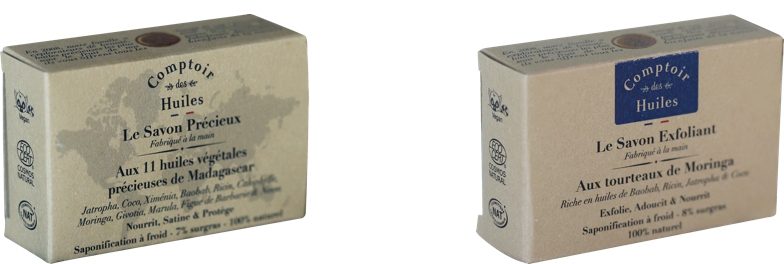Contents
Cold saponification: all about cold saponified soaps
Cold saponification is a process for making soaps at room temperature. It requires few ingredients and you can, under certain conditions, make it yourself. This method of saponification keeps all the benefits of the soap for the skin.
The advantages of cold saponification
The principle of cold saponification
Cold saponification is a simple chemical process that requires only two main ingredients: a fatty substance, which can be vegetable oil or butter, as well as a “strong base”. For solid soaps, this is usually soda, a caustic ingredient to be used with great care. For liquid soaps, it will be potash (a mineral).
In either case, the strong base is what will allow the fatty substance to turn into soap. But the finished product, the soap, will no longer contain any trace of soda, or of potash for liquids.
Cold saponified soap and its benefits
Generally speaking, cold saponified soap has great advantages over industrial soaps. On the one hand, the ingredients used are simple, while some soaps from the mass market contain ingredients that are sometimes not very advisable. There are often synthetic fragrances, preservatives that can be problematic and even animal fat.
On the other hand, unlike soaps produced industrially and whose heating process eliminates most of the benefits expected from a soap, cold saponified soaps retain their properties. The first of these is hydration, thanks to the glycerin that emerges from the saponification process. Or even excellent vitamins for the skin, A and E, anti-oxidant and protective.
Cold saponified soaps bring a lot of benefits to the epidermis and are suitable even for sensitive or atopic skin prone to allergies. However, if they are suitable for the body, they can be drying on some faces.
Soap making
Saponification at? cold in trade
Cold saponified soaps are of course available more particularly in artisan shops and markets, but also in certain traditional shops or in drugstores.
In any case, find out about the origin of the soaps on the label. Cold saponified soaps are in great demand and are indicated as such. However, there is no official label that is authentic, apart from an increasingly widespread non-compulsory logo: “SAF” (cold saponified soap). There are mentions of the “slow cosmetic” or organic type that can also guide you.
Manufactured by small soap producers or by eco-responsible cosmetics companies, they are produced in more or less large quantities, but with the same basic ingredients and on the same principle.
The advantages of doing cold saponification yourself
With the advent of home-made (or DIY, do it yourself) in all areas of life, cosmetics were the first to be revisited. Among them, soaps have the advantage of being composed of ingredients that are easy to obtain. You can also choose them according to your desires or possible skin problems.
Making your own soaps using this method is also a rewarding activity. You will be able to diversify the ingredients, do many tests and, why not, offer them to those around you.
How to make soap yourself with cold saponification?
Even if it is possible to do everything yourself when it comes to cosmetics, making your own soap, like many other products, cannot be improvised. Especially since cold saponification requires the use of caustic soda *, a chemical that is dangerous to handle.
This is a slow process, which requires a precise calculation of the level of soda in relation to the quantity of fatty substance, until the complete dissolution of the strong base. In addition, drying for at least 4 weeks is mandatory for optimal use of the soap.
Vegetable or mineral dyes can be added to the mixture to add color. As well as essential oils for their benefits and their fragrance.
In any case, orient yourself towards precise recipes and refer to calculation tables to avoid any problems.
* Warning: do not confuse caustic soda with baking soda or soda crystals.
What is the difference with Marseille soap or Aleppo soap?
Real Marseille soaps and Aleppo soaps are natural soaps also based on vegetable oils. However, both require heated preparation, which by definition distinguishes them from cold saponification.
In the purest tradition, Marseille soap is cooked for 10 days at 120 ° C. For Aleppo soap, it is olive oil alone which is first heated for several days, before the addition of bay laurel oil.










